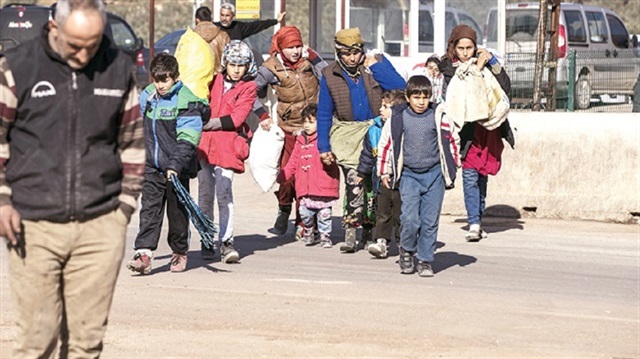
Turkey’s ongoing Operation Olive Branch in Syria’s northwestern Afrin region has brought hope to 6 million displaced Syrians yearning to return to their towns and villages that were overrun by terrorists from the Kurdistan Workers’ Party (PKK)’s Syrian offshoot, the PYD, and other terror groups.
In the wide-ranging Euphrates Shield Operation launched in August 2016, the Free Syrian Army -- with the support of the Turkish army -- had cleared 2,000 square kilometers (772 square miles) of land along the Turkish-Syrian border of terrorist elements, including the cities of Jarabulus and al-Bab, which enabled 150,000 Syrian refugees to return home.
About 500,000 Syrians are expected to able to return to their towns and villages in northern Syria thanks to Turkey’s ongoing Operation Olive Branch in Afrin.
On Jan. 20, Turkey launched Operation Olive Branch to clear PYD/PKK and Daesh terrorists from Afrin, northwestern Syria.
According to the Turkish General Staff, the operation aims to establish security and stability along Turkey’s borders and the region as well as to protect Syrians from terrorist oppression and cruelty.
The operation is being carried out under the framework of Turkey's rights based on international law, UN Security Council resolutions, its self-defense rights under the UN charter, and respect for Syria's territorial integrity.
Turkey has long argued for the establishment of a “safe zone” for Syrians fleeing the violence as a way to solve the refugee crisis that has been one of the biggest problems for Europe and the UN.
While the world remains silent to the plight of Syrians, Turkey’s operations in the country will gradually enable refugees to return home after the region is cleansed from terrorists.
Since the outbreak of the civil war in 2011, Syria has been embroiled in one of the largest humanitarian tragedies, with a sharp decline in its population, which stood at 22.5 million in 2012.
Millions of Syrians are currently internally displaced in the war-torn country, in addition to the 6.1 million others who sought refuge in neighboring countries.
Turkey, which has opened its doors to fleeing Syrians since the start of the conflict, hosts the largest number of Syrian refugees at 3.5 million, according to official figures.
After Turkey, Lebanon comes second among the countries hosting Syrian refugees, with 1 million fleeing the violence to the small neighboring country.
With 650,000 registered Syrian refugees, Jordan comes third, followed by Germany, the UAE and Iraq, which host 300,000, 240,000, and 239,000 Syrians respectively.
There are also significant Syrian refugee populations in Kuwait, Egypt and Sweden, in addition to the tens of thousands of Syrians who sought refuge in Hungary, Austria, Canada, the Netherlands and Libya.
A research conducted by Turkey's Disaster and Emergency Management Authority (AFAD) into the causes behind Syrian displacement found that a majority of Syrian refugees, or over 57 percent, have fled the country due to “security concerns.”
Close to 36 percent of total Syrian refugees in Turkey hail from the flashpoint city of Aleppo, while 21 percent sought refuge from the border Syrian province of Idlib.

















